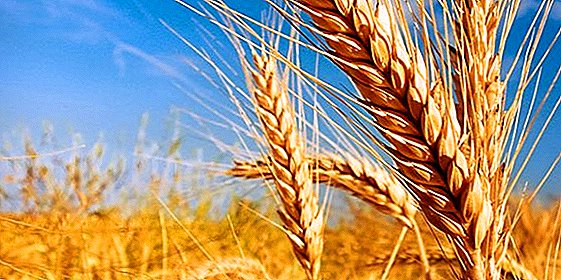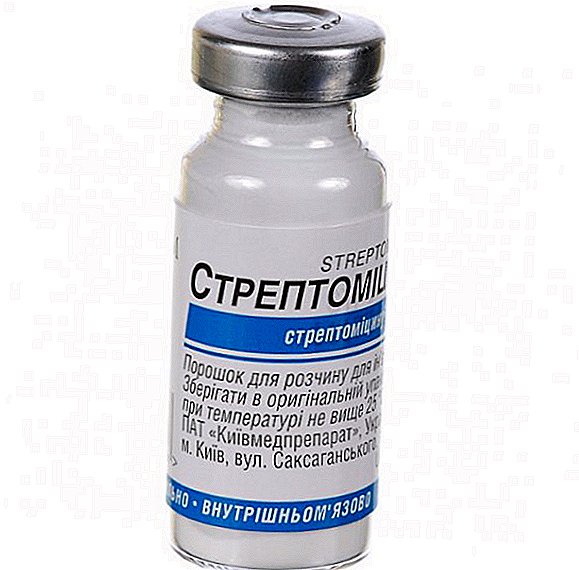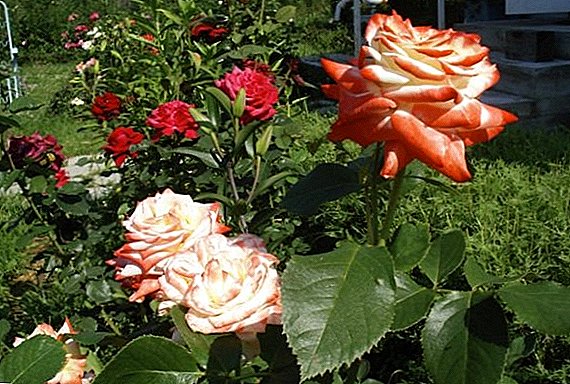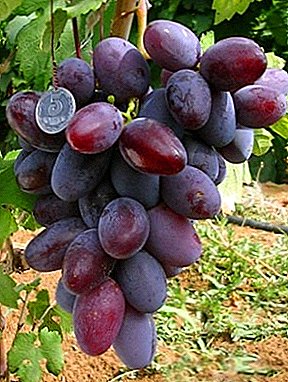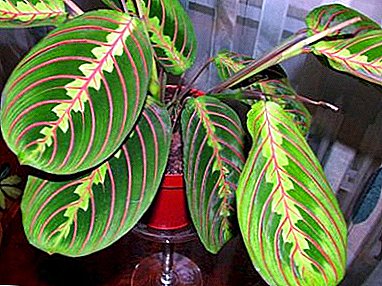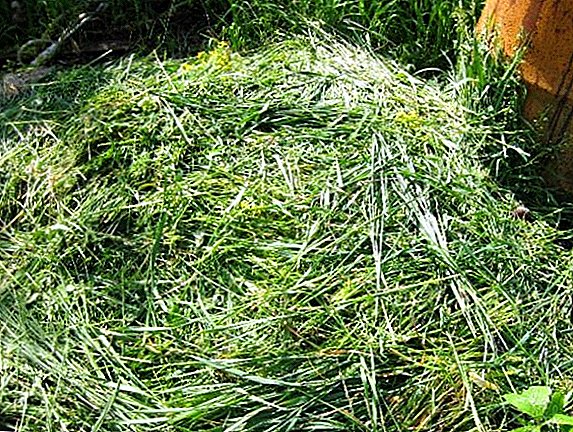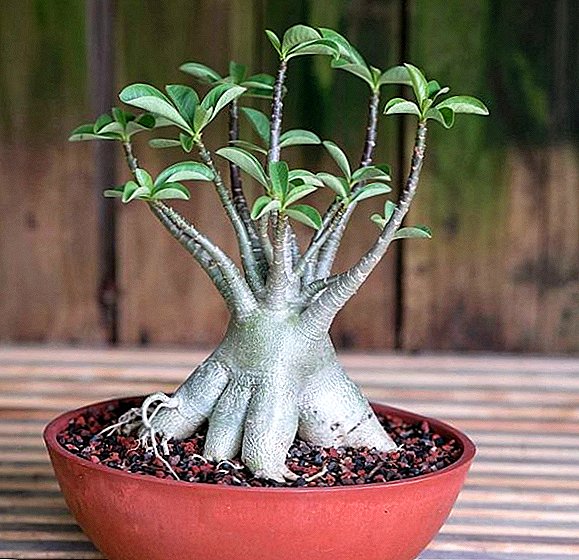 Adenium corpulent is also called the Impala Lily or Desert Rose. This luxurious flower at the same time attracts with its enchanting beauty and repels poisonousness. It can not be grown in a house where there are small children and pets, and care for him requires special care. Learn about the peculiarities of the cultivation of exotic succulent in the conditions of the room and the street further from the article.
Adenium corpulent is also called the Impala Lily or Desert Rose. This luxurious flower at the same time attracts with its enchanting beauty and repels poisonousness. It can not be grown in a house where there are small children and pets, and care for him requires special care. Learn about the peculiarities of the cultivation of exotic succulent in the conditions of the room and the street further from the article.
Origin of the flower
Brightly blossoming adeniums are common for the natives of tropical and subtropical latitudes. Small-leafed shrubs or stunted trees with thick trunks and dense buds are often found on lands from the borders of Senegal to Kenya, Sudan and Arabia. This area is considered the original homeland of the plant.
In ancient times, when forest thickets raged on the site of the African and Arabian deserts, these low representatives of the Kutrov family were in abundance blooming on sunny lawns. As a result of global warming, the climate has radically changed, and the former tropical thickets have turned into deserts.

The local population without water could not adapt to new conditions and migrated to other lands. Many exotic vegetation died, but adeniums remained. In the process of adaptation, they built up thick trunks, which, under drought conditions, twisted into freakish figures. Due to the moisture accumulated there, the plant has preserved the splendor of its flowering. That is why it was called the desert rose.
The culture appeared in floriculture relatively recently, but immediately gained recognition among lovers of plant exoticism. Today, the selection of succulents has been replenished with new varieties with double and semi-double flowers, specks and borders on the petals, and the variety of colors of inflorescences has become diverse (yellow, bright red, cream, variegated have been added to the traditional white and pink species).
Did you know? Contemporaries often use succulent rosettes as living jewelry, planting these unpretentious plants in miniature grooves in pendants, earrings and bracelets.
Description of indoor plants
Adeniums combine a genus of undersized shrubs and trees of the Kutrovy family, differing in strongly thickened trunks and increased branching. In the genus of adeniums, biologists distinguish 5 species, among which the fat (or fat) variety is particularly popular in room floriculture. The plant is characterized by a well-developed rhizome, a dense fleshy trunk, which has the ability to accumulate moisture, and sprawling branches with lanceolate glossy foliage, pointed or dull in shape.

Only mature specimens that are more than one and a half years old bloom. Bright, funnel-shaped buds with proper care appear in the period from spring to autumn and delight the eye, depending on the variety, from 2 to 12 months. In the garden and in the apartment, the vase with a thick trunk up to 70 cm high and a densely blossoming bright crown look spectacular. On average, the diameter of the open flowers reaches 7 cm. Inflorescences without aroma. Having adapted to the conditions of the desert, adenium is not demanding to care, it takes root well in flower pots and grows quickly.
The main drawback of the exotic succulent can be considered poisonous juice, released during cuts and mechanical damage to the aerial parts. Once in the human body, the poison causes severe intoxication, therefore, all work on the cultivation of adenium, should be carried out in rubber gloves, and after that thoroughly wash with soap and water.
Care and growing conditions
All adeniums are classified to flowering plants. But in order to achieve their successful flowering, it is necessary to ensure optimal conditions and follow elementary agrotechnical rules in the care.
Pot selection
A distinctive feature of fat adenium in comparison with other succulents is the propensity to intensively build up a powerful root system. The underground part of this flower develops much faster than the aboveground part. Consequently, the diameter of the planting container should correspond to the size of the rhizome.
Did you know? At home, their adeniums juice was used in the manufacture of poisonous arrows and mines. These traditions are still relevant today for some African tribes who live far from civilization.
Experts advise to give preference to wide tanks. They need to be chosen, conditionally tripling the diameter of the ground part of the trunk. However, do not plant a small sapling in an overly large pot. If necessary, transplant the plant. Otherwise, root rot development is inevitable.
Of the widest range of flower pots for growing desert roses, ceramics and clay products are more suitable, although plastic, glass, and metal options are also acceptable. The choice depends on the preferences of the grower.
But it should take into account the following nuances:

- Ceramic and clay unglazed containers promote aeration of the roots, as well as, due to the wide pores, allow the evaporation of excess moisture. In addition, hydrated water in such tanks is an excellent thermostat. That is, in winter the plant is warm and cool in summer. Such products are resistant, which is why they are ideal for growing shrubs and tree crops. Among the shortcomings of ceramic and pottery for flowers are the abundant salt deposits protruding on its surface, as well as the fragility of the material. If you do not transplant the overgrown adenium in time, its strong roots will simply destroy the vessel.
- Plastic pots are easy to move, which is important for the overall succulent. Some of their variations are equipped with an automatic irrigation system. This is a kind of pot with a deep pots, which made a hole for watering, as well as an indicator of the moisture content of the substrate. This design allows to minimize irrigation up to several times a year. Convenience, availability, variety of shapes and colors of plastic products are their main advantages. Among the "minuses" - artificiality of the material, which prevents the penetration of oxygen into the substrate. In addition, when overwetted, such containers often lose their stability.
- Glass vessels are fragile and traumatic, but attractive because of their decorative effect. They do not allow air and moisture. But for undemanding small succulents that do not need frequent watering may well be suitable. Mature plants are better not to replant in such products.
- Stone products look very impressive in high spacious rooms with panoramic windows and in large gardens. But they are impractical because of their severity, as well as the high cost of living. In such vessels, the roots are poorly fed with oxygen, and in the summer they suffer from overheating.
- Metal containers are unprofitable due to the fact that, depending on weather conditions, they quickly heat up and cool down. Moreover, in contact with water, the material after some time damages corrosion.
Important! To distinguish a flower pot made of natural clay or ceramics from a plaster fake, knock on it. When tapping lightly, the plaster container will make a dull sound, and the clay counterpart will make a clear and resonant sound.Keep in mind that the shape of the roots and, accordingly, the crown of adenium will directly depend on the depth of the planting container. In small spherical containers, the plant will grow faster, but the moisture there will begin to evaporate rather than deep vessels. In the pot-shaped pots a spreading rhizome and a wide squat stem are formed, and in deep pots, on the contrary, it is thin and tall.
In cramped conditions, the succulent stops its growth. But in the case of indoor growing it is beneficial, since the pot will be placed on the windowsill in 10 years.
Soil and fertilizer
Despite the adaptability to the desert conditions of wild adeniums, room varieties react painfully to the wrong soil. For full growth and abundant flowering, the plant requires a decontaminated nutritionally balanced mixture with neutral acidity, as well as with good moisture and air permeability.

Many growers use purchased substrates for succulents as a basis for planting adeniums (but they must be diluted with a sufficient amount of baking powder). When choosing them carefully you should study the composition and pay attention to the pH level. An acidic medium (when the pH is below 5.8) and alkaline (pH above 7) are categorically inappropriate.
Impala lily is well acclimatized in the land consisting of:
- substrate for cacti or peat (50%);
- perlite or garden soil (25%);
- vermiculite (15%);
- river sand (10%).
Important! When using leafy land for planting adeniums, it is better to recruit it under lindens or birches.
Top dressing for adeniums are relevant only when they are at the stage of active development. Their components and frequency depend on the nutritional value of the substrate and the age of the flower, because its intensive growth is observed only up to 1 year. In the period of stagnation, as well as disease, pest attacks and in case of gross violations of the agrotechnical rules of cultivation, fertilizing is not recommended.
Regular fertilization is appropriate when:
- the soil is half composed of drainage components;
- among its components there are no (or few) nitrogen-containing substances;
- growing conditions (temperature, lighting, moisture) do not fully meet the requirements of the flower.
Suitable for dressings:
- solution of infusion of chicken (or pigeon) droppings;
- mineral complexes based on nitrogen, phosphorus and potassium in the ratio of 9: 3: 6.
Young seedlings need more nitrogenous components, and more mature their number is minimized.

Fertilization is advisable to plan on the scheme below:
- healthy vases - once a month;
- under excellent conditions of detention from the best - 1 time in 2 months.
Before each fertilizer, succulents require prior abundant watering (one hour before fertilization).
Temperature and humidity
The flower develops properly with stable heat. This is important because temperature fluctuations affect the development of the plant. In summer, the optimum temperature for it should be + 20 ... + 35 ° С, and in winter - within + 16 ... + 12 ° С.
If you grow a pot at a temperature above + 38 ° C or below + 10 ° C, its growth will stop, and a prolonged period of stagnation will begin. In the resting stage, a short-term lowering of the thermometer to + 5 ° C is permissible, provided that the flower is grown in a dry mode (low humidity of air and soil).
Important! When preparing the nutrient substrate for transplantation of fat adenium, you must disinfect the river sand and garden soil. This can be done by calcining, scalding with boiling water or watering with a weak solution of potassium permanganate.Saplings up to one year are recommended to be grown at high humidity (up to 90%), since during this period they actively develop. In the future, this indicator, with the exception of periodic phases of rest, should not be below 70%, otherwise the quality of flowering will decrease.
In order to properly settle the temperature and humidity regimes, experts advise to increase the level of moisture as the temperature rises.
Lighting
Direct sunlight throughout the daylight hours are simply necessary for plants whose homeland is the African and Arabian deserts. For timely flowering of the Imperial lily you need bright lighting for 12 hours.

For this, many growers advise to use the following electrical appliances:
- fluorescent lamps (fluorescent);
- phytolamps (for example, FLUORA OSRAM);
- universal lamps (for example, BIOLUX OSRAM);
- LED blue and red lamps (for example, PHILIPS GREENPOWER LED);
- sodium lamps for the agricultural industry (for example, AGRO PHILIPS or PLANTASTAR OSRAM).
Did you know? According to bioenergetics, adeniums bring misfortune and disaster into the house.
Cropping and crown formation
Natural branching in the fat variety of adenium begins after 4-5 years of growth. In order to speed up this process, many growers pinch the top of the central trunk. However, for young flowerpots, this procedure does not make sense, since the pinching causes the nearest bud to wake up close to the cut, and the growth of a single stem continues.
In more mature specimens (after 3 years), such manipulations during the active growing season stimulate the development of the lower 2-3 buds. There are cases when, as a result of pruning, many previously dormant buds are activated, of which unnaturally thin and fragile shoots grow over time. In such situations, the bulk of the shoots need to be eliminated.

In order for the formation of the bush to bring the expected results, follow the rules below:
- The optimal period for cutting is March - July. Its relevance is based on the absence of flowering and chaotic branching of the bush.
- A rejuvenating pruning is required annually, the essence of which is to eliminate old branches without foliage.
- With each transplantation, it is recommended to shorten the root shoots, since this species is prone to intensive growth of secondary roots. The place of the cut must fall on the boundary of the connection with caudex.
- In order for the grafted branches to bloom, the graft needs to be cut, leaving about 3 cm of its length. Also on grafted adeniums it is recommended to remove excess shoots appearing on the graft, otherwise it will stop in growth.
- Before each pruning, the plant is washed with warm water. And removal of excess vegetation is carried out at a temperature of + 22 ... + 24 ° С.
- Juice, which in large quantities stands out from each slice, does not gloss over. The flow ceases naturally a few days after trimming. Toxic injections to the eyes and mucous membranes are unacceptable.
- When removing diseased parts of the hive, the slices must be disinfected with a weak solution of potassium permanganate. The same manipulations are carried out before each contact with the cutting tool to the healthy parts of the plant.
Important! To maintain the required level of humidity in the room where adenium is grown, it is recommended to periodically spray water with a spray bottle. Also not superfluous spraying the flower.
Transfer
The annual transplanting of adenium into another large-sized pot ensures the successful formation of peduncles.
It is necessary to carry out this procedure, taking into account the following signals:
- when the rhizome of a flower has grown strongly and has surpassed the size of an old pot (cases of its deformation or deterioration are not excluded);
- the plant slowed its growth, it began to bloom poorly, and the buds crushed;
- there were signs of salinization of the substrate (this is indicated by whitish discharge from the soil);
- with severe damage to the root system, as well as death threatening diseases;
- when the pot for a long time did not transplant.
Adeniums, like other indoor plants, can be transplanted, completely replacing the potting substrate and planting capacity, or reloading, placing the old earthen clod in a new pot. In the first variant, the root growth is severely injured, which affects the further development of the culture. But it is essential for young plants. The second method is more suitable for mature vases.

It is better to plan both procedures in spring, before the beginning of the active growing season. Especially they are relevant in the first 6 years of growth, in the future the plant can be transplanted every 4-6 years.
Literate transplantation should be carried out according to the following algorithm:
- removing the pre-moistened plant from the old container;
- careful cleaning of the root system from the old substrate (at this stage it may be necessary to wash the root processes under running water);
- radical pruning of the rhizome and the formation of caudex;
- drying of sections, including the treatment of large wounds with fungicides (Skor, Maxim, Fundazol);
- selection of a new pot with a large diameter, its disinfection, further filling with the prepared nutrient substrate and direct rooting of the flower.
Did you know? Adenium needs good drainage. To do this, suitable foam, broken brick, expanded clay. Charcoal is recommended only for seedlings, but by no means for adults and grown plants. Cold pebbles are not allowed as a basis for drainage.
Breeding methods
It is very simple to propagate a beautifully flowering succulent. Новый саженец можно получить из стеблевых черенков или семян.
Seeds
Choosing this method of reproduction of fat adenium, you need to immediately decide on a reliable supplier of seed material. Having made a purchase, do not tighten the crops, since germination of grains is short-lived.

It is better to plan the planting in the spring, when the plant enters a phase of active growth, and there is enough natural light for its full development. In other cases, do not do without artificial lights. Experienced hostesses pre-soaked the seeds in a barely pink solution of potassium permanganate for 2-2.5 hours before planting.
In the meantime, a soil mixture is prepared from disinfected:
- river sand (1 hour);
- sifted charcoal (2 hours);
- perlite (0.5 hour);
- garden land (0.5 hours).
It will not be superfluous to dip the planting material for a short time into any growth stimulant (Ecosil, Emistim, Kornevin). After that, it is deepened to a substrate warmed to room temperature by 1-1.5 cm, it is tied up with a film and placed on a warm, well-lit place. It is important to monitor the level of moisture in the container, raising it with a spray bottle, and periodically ventilate the seedlings.
Read more about how to grow adenium from seeds.
They will appear in 2 weeks. When the first pair of leaves is formed on the grown shoots, it is time to transfer the adenium into a separate pot of appropriate sizes. In this case, you can use the soil, as for adult specimens during transplantation. Seed method is very time consuming, but allows you to save all varietal signs of shrubs and achieve its early flowering. True, in this case it will be difficult to form a wide caudex.
Cuttings
For planting, it is better to harvest the apical parts of the strongest sprouts so that their length reaches 12 cm. It is advisable to treat the cut sections on the flowerpot and the cutting with charcoal ground into dust. Then, the resulting twigs need to wrap up for 1-2 days.
Planting cuttings should be carried out in a sand-perlite mixture at a slight inclination. Containers with plants should be placed in a warm and well-lit place, where the air temperature corresponds to the range + 24 ... + 26 ° C.

Some flower growers practice rooting of air layers, making a shallow circular incision of the bark. After treating the wound with “Kornevino”, the shoot, on which the manipulations were carried out, is tied up with sphagnum and film. After a month, provided regular watering, small roots form at the site of the incision. Then the stalk is completely separated from the parent bush and planted in a new pot. Over the moss fix film. Under the bandage regularly pour water during the month. After this period, you can find small roots. Now the stalk is completely separated and planted in a pot.
Important! With a deficit of potassium, a reddish burn edge appears at the edges of the lower foliage, and a deficiency of fluorine generally stops the development of the plant.
Features of cultivation in the open ground
Given the origin of the fat variety of adenium, the harsh freezing climate of middle latitudes cannot be recommended for a thermophilic flower. And since in temperate climates it is difficult to artificially achieve desert conditions, it is better to grow an Impala rose in open ground only in hot summer.

Some hostesses are limited only by the fact that with the onset of heat they take out pots with a plant in the sun in the garden or put it on a well-lit balcony with a southern orientation. However, according to experts, a seasonal change of soil will be useful for a desert rose.
Before deciding on the place of cultivation of adenium, the florist should pay attention to his requirements:
- stable temperature of + 25 ° C in summer and + 12 ° C in winter (if the thermometer column drops below + 6 ° C at least once - the bush will die);
- the need for regular pruning, because on free ground the succulent rhizome and crown will grow strongly on the ground (it can reach 3 m in height);
- protection from heavy rainfall and pests, since these factors adversely affect the health of the crop;
- regular feeding (without this, despite the intensive growth of root shoots, the trunk will develop poorly).
Important! After pruning, take care of the cut-off area from water ingress, as this may cause putrid infections.
Major diseases and pests
Succulents are ill only with gross violations of the agrotechnical rules for their cultivation.
In such conditions, adeniums are sensitive to:
- Root rotting (arises due to inconsistencies between the soil and air moisture regime, as well as due to overflows in winter). You can solve the problem by adjusting the irrigation in accordance with the requirements of the culture.
- Burns (The reason for their appearance is a sudden change in lighting, especially after wintering, when the flower is immediately exposed to the sun). To avoid this, it is recommended to gradually accustom the plant that has come to life after stagnation to direct sunlight.
- Fungal diseases, expressed round spot on yellowed and faded foliage. Only the removal of damaged branches and the sprinkling of the entire bush with the fungicide "Fundazol", "Skor", "Maxim" can destroy the pathogenic medium.
- Yellowness at the edges of foliage (manifested as evidence of a lack of nutrients in the soil). To solve the problem, extra fertilizing with complex mineral fertilizers is required.
Adeniums are not demanding and responsive to basic care. And their gratitude can be considered a long bloom with luxurious bright buds.


